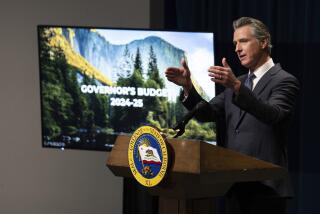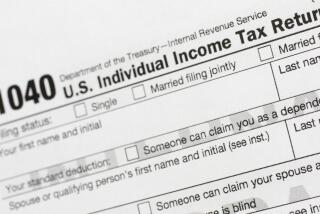TAXES REFORMED : TAXES RESENTED
- Share via
WASHINGTON — April, when the Internal Revenue Service is most on the public mind, is also the month when the federal income tax--and the far-reaching modifications made in 1986--commands greatest attention in the print and broadcast media. Yet most discussions have ignored a potentially explosive aspect: While academic, political and journalistic elites cherish the 1986 income tax overhaul--which reduced rates by curbing deductions and credits--the public considers it a turkey.
It’s not an abstract disagreement. An aroused electorate could become a force for rescripting federal tax policy during the 1990s. Succinctly put: Public opinion appears to favor re-establishing tax-bracket progressivity--the principle of significantly higher rates for higher income groups so much eroded during the 1980s. Doubters should recall that such a turnabout has happened once before--when the top income tax rate fell to 25% during the 1920s, but then climbed back to 65%, and then 75%, during the 1930s.
Today’s critical gap in public versus elite perceptions goes back to 1985-1986. That’s when Washington’s “inside the Beltway” economists, congressmen, journalists and lobbyists--not all for the same reasons--jumped on the bandwagon of reducing tax rates, eliminating deductions and simplifying the tax code, in the process overselling “reform” to audiences and constituencies alike. Moreover, these accolades were delivered even though the tax changes involved were “revenue neutral”--rates would be slashed to 28%, but nothing would be done tax-wise to reduce the $200-billion federal budget deficit.
The catch--as serious chroniclers have acknowledged--is that the American people were never quite convinced. When President Ronald Reagan called it “the people’s tax cut,” the public yawned. Then-Deputy Treasury Secretary Richard G. Darman said it would realign national politics in favor of the Republicans; the electorate ignored him. And when Rep. Dan Rostenkowski (D-Ill.), chairman of the tax-writing House Ways and Means Committee, pledged the enthusiastic cooperation of congressional Democrats, grass-roots apathy continued.
Then, by 1988, as citizens began to file and pay taxes under the revised system, those public doubts started hardening into hostility. Much of what Washington politicians had promised was nowhere in evidence. One March, 1988, ABC News survey found a 55% to 31% majority saying reform had made the tax system worse, not better. A second, for the Cable News Network, found 67% describing the new law as more confusing than the prior one, while 60% thought it benefited the rich.
A visitor from Mars might have thought these findings represented a big story: an expose of public refusal to be flummoxed. Not so. Few journalists probed grass-roots skepticism and Washington-worship of the 1986 tax reform act continued--as did White House and congressional unwillingness to tamper with the new rate structure, even on behalf of deficit reduction. Analysts continued to cite “polls” showing that the public opposes raising taxes to reduce the deficit.
True--but also false. Of course, the electorate doesn’t want taxes in the broad, middle-class sense raised--and why should they? Today’s burden is high enough, voters feel. Studies by the Congressional Budget Office show that when all federal taxes are combined, the average American’s effective federal tax rate is roughly the same now as it was back in 1977. Increases in Social Security levies have counterbalanced small net reductions in income taxes.
Only among the top 10%, 5% or, especially, 1% of Americans has the overall effective federal tax rate dropped. Indeed, for the fortunate top 1% of Americans, the three-stage reduction of capital gains and income tax rates that took place in 1978, 1981 and 1986 has had the effect of dropping their net effective federal tax rate from 31% in 1978 to just 25% in 1988--a considerable benefit. This is what critics cite when they describe the net effect of combined federal tax changes over the last decade as helping upper-income groups but doing little for those in the middle.
So popular disillusionment is understandable. Whatever Reagan might have intended to deliver, most average Americans never got it. In the meantime, of course, John Q. Public has been drawing his own cynical conclusions from the record number of BMWs and Mercedes on the highways and the record number of yachts off San Diego or along the Intercoastal Waterway. The upshot is that while voters oppose a broad tax increase, they do have definite preferences if more revenue is needed. Increasing alcohol and tobacco levies is one; raising income-tax levies on corporations and upper-tier individuals is another.
Both sentiments, in fact, are quite lopsided. Higher taxes on alcohol and tobacco have a social and medical, as well as fiscal, incentive. As for higher taxes on the rich--popular motivations are ideological and cultural as well as fiscal. After all, Middle America never really signed off on the 1980s tax philosophy of eroding the progressivity of the U.S. tax system--by droping the rates for highest-income Americans from 70% to 28% in just seven years. Citizens seem even less happy now. Just as recent opinion polls display public sourness over the clumsiness and bias of the 1986 tax “reform,” they also suggest the electorate’s apparent preference for rebuilding the progressive federal income tax during the 1990s.
Because the subject is so controversial, let me cite some data. Louis Harris polling in December found 62% to 35% support boosting the federal tax rate for high-income Americans from 28% to 38%; while a survey taken by Gallup for the Times Mirror Co. in May, 1988, charted 64% of the public supporting increasing income taxes for those making more than $80,000 a year. An autumn sampling by Money magazine found 69% of those polled prefer a presidential candidate willing to raise taxes for people with incomes of $100,000 a year or more--casting doubt on the conventional wisdom that softness on tax increases has been fatal to Democratic presidential nominees.
Most recently, February’s Gallup/Times Mirror poll showed the percentage of Americans in favor of raising income taxes on those making over $80,000 soaring to 82% from last May’s 64%. Part of the uptick mirrored growing concern over national economic polarization--an unexpected 58% to 30% majority agreed that the gap between rich and poor was getting wider, “shocking” Gallup President Andrew Kohut. This, too, could hint at an emerging issue of the 1990s.
At the least, such sentiment jeopardizes inside-the-Beltway hope that the sharp bracket cuts of the 1980s have been set in concrete by the 1986 tax overhaul. Future historians may judge that America’s agenda-setting elites took an unwise gamble in treating 1985-86 public apathy as genuine support for tax reform and then ignoring the negative rumblings of 1987-89.
Opinion data suggests that the upper-income rate cuts of the last decade could be vulnerable on populist as well as deficit-reduction grounds. And if there’s a latter-day liberal version of conservative tax revolt leaders like Alabama’s George Wallace or California’s Howard Jarvis even now polishing his rhetoric in some Oklahoma PTA hall or Midwest state legislature, the U.S. tax code could look a lot different by the mid-1990s. After all, a major tax “reform” is unlikely to last when it’s rated by the public as worse and less fair than the unpopular preceding statutes and regulations. The ups and downs of the last 70 years show all too clearly that income tax rates, like U.S. Supreme Court decisions, follow the election returns.
More to Read
Get the L.A. Times Politics newsletter
Deeply reported insights into legislation, politics and policy from Sacramento, Washington and beyond. In your inbox twice per week.
You may occasionally receive promotional content from the Los Angeles Times.










